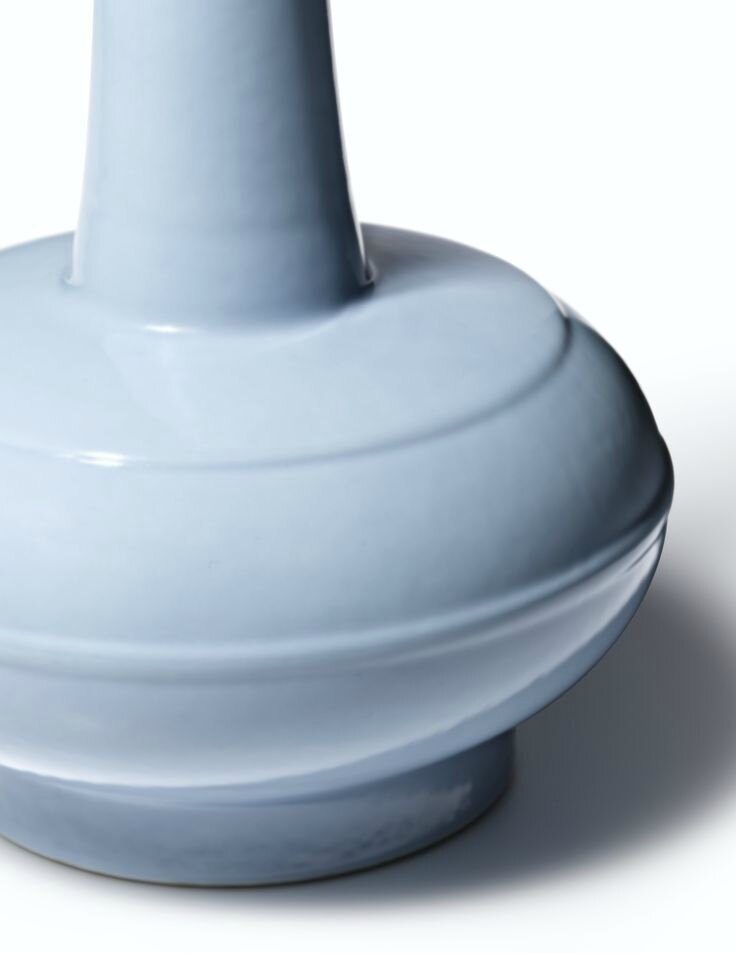An extremely fine and rare lavender-glazed bottle vase, Mark and period of Yongzheng (1723-1735)
Lot 110. An extremely fine and rare lavender-glazed bottle vase, Mark and period of Yongzheng; 31.5 cm., 12 3/8 in.. Estimate 10,000,000 — 15,000,000 HKD (1,140,158 - 1,710,238 EUR). Lot sold 15,680,000 HKD. Photo: Sotheby's.
exquisitely potted with a compressed globular body rising from a slightly splayed foot to a tall slender tapered neck and a wide galleried mouthrim, the body encircled by two slightly raised ribs, covered overall save for the interior and underside with an even rich opaque bluish-lavender glaze, the base inscribed in underglaze blue with a six-character reign mark within a double-circle.
Provenance: Collection of Edward T. Chow.
Sotheby’s Hong Kong, 3rd May 1994, lot 97.
Exhibition: One Man’s Taste from the Lakeside Pavilion, Galleries of the Baur Collection, Geneva, 1988-89, cat. no. C12.
Note: This vase is an archetypal example of Yongzheng monochrome porcelain in its gracefulness and refinement of form. Under the emperor’s keen eye, which was steeped in a thorough knowledge of the antiquities in the imperial collection, a profusion of new shapes and colour emerged which was only possible through the great technical advances that were achieved by his reign.
The form, inspired by a Song prototype, has been given a fresh modern aesthetic through the crispness of the silhouette and raised bands. The tall narrow neck on a comparatively small compressed body and the angularity at which these two elements join are testament to the potter’s supreme skill. Deceptively modest in appearance, vessels such as the present vase represent one of the greatest aesthetic and technical triumphs: perfection could only be attained through a flawlessly formed vessel covered in the purest of glazes and fired at the precise temperature. Thus the saying ‘nine failures for ten charged kilns’ expresses the complexity and perfection of process required for successful pieces.
A vase of this unusual form and size, also bearing a Yongzheng reign mark and of the period but covered in a glaze simulating Jun ware, is published in Julian Thompson, The Alan Chuang Collection of Chinese Porcelain, Hong Kong, 2009, pl. 76; and another with a pale sea-green celadon glaze, was sold in these rooms, 14th November 1989, lot 166. See also a pair covered in a similar glaze described as clair-de-lune in the catalogue, from the George A. Hearn and J. Insley Blair collections, sold at Christie’s Hong Kong, 28th November 2012, lot 2120.
For the Song original compare a Ge vase with an everted rim, which was probably in turn inspired by a metal prototype, illustrated in The Complete Collection of Treasures of the Palace Museum. Porcelain of the Song Dynasty (II), Hong Kong, 1996, pl. 38. The neck of this vase can also be compared to that of a Longquan celadon vase included in the Special Exhibition of Sung and Yuan Porcelains, National Palace Museum, Taipei, 1971, cat. no. 7.
Sotheby's. Yongzheng – The Age of Harmony and Integrity, Hong Kong, 07 avr. 2015

/https%3A%2F%2Fprofilepics.canalblog.com%2Fprofilepics%2F1%2F0%2F100183.jpg)
/https%3A%2F%2Fstorage.canalblog.com%2F03%2F02%2F119589%2F96711876_o.jpg)
/https%3A%2F%2Fstorage.canalblog.com%2F11%2F31%2F119589%2F94773502_o.jpg)
/https%3A%2F%2Fstorage.canalblog.com%2F20%2F83%2F119589%2F94772815_o.jpg)
/https%3A%2F%2Fstorage.canalblog.com%2F26%2F72%2F119589%2F75604929_o.jpg)
/https%3A%2F%2Fstorage.canalblog.com%2F59%2F60%2F119589%2F26458628_o.jpg)





/image%2F1371349%2F20240331%2Fob_a6f470_2024-nyr-22642-0857-000-a-large-black.jpg)
/image%2F1371349%2F20240329%2Fob_2f6b6c_854-1.jpg)
/image%2F1371349%2F20240329%2Fob_54ca74_114-1.jpg)
/http%3A%2F%2Fstorage.canalblog.com%2F77%2F04%2F119589%2F129856496_o.jpg)